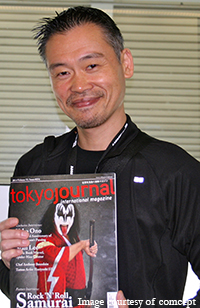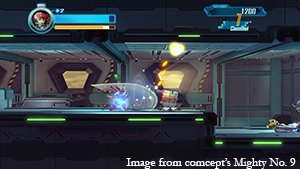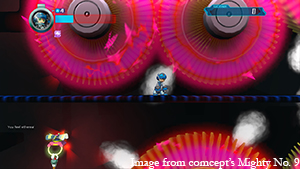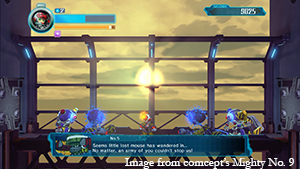Keiji Inafune Stays Ahead of the Game
From CAPCOM to comcept
Keiji Inafune has been named one of the top 10 game creators in the world. The video game concept developer and designer had a stellar 23-year career at CAPCOM as head of the production, research & development and online development divisions. He oversaw over 900 employees and produced over 60 game titles including CAPCOM’s bestselling hits Mega Man, Street Fighter, Resident Evil, Dead Rising, Lost Planet and Onimusha. In 2010, he went on to found comcept Inc. and in 2013 the company successfully raised over $4 million in funding from 70,000 backers through Kickstarter for his newest project, the Mighty No. 9. Tokyo Journal Executive Editor Anthony Al-Jamie met with Keiji Inafune at Anime Expo 2014 in Los Angeles to find out more about this innovator.

TJ: How did you end up joining the game industry?
INAFUNE: I’ve always loved anime, manga and illustration. I studied art in school, and tried to think of what career I could pursue as an artist. I was interested in the idea of video game character design, which was a pretty novel idea at the time. I entered the industry as a designer, but I also enjoyed the game creation aspect, eventually becoming a producer myself.
TJ: Could you give us a simple rundown of the game creation process?
INAFUNE: Everything starts from a single idea we call the concept. Planners and artists expand on this idea; building it into a design. Next, we create a game prototype that lets us experience both the concept and the design. We play it, test it, and if the game seems interesting we proceed to development.
TJ: What aspect of this process do you participate in personally?
INAFUNE: All of the games created by my company come from my ideas and concepts. I’m involved in the whole process from start to finish, checking each milestone such as the designs and prototypes.
TJ: What’s been the most challenging aspect of the game industry in recent years? What hurdles do you face?
INAFUNE: Wrestling with costs. With a fair sum of money you can make a good product, but the risks increase with the costs. You have to strike a good balance, but that’s easier said than done. If you try to play it safe, you just end up making a sequel to some famous series. When that happens you’re putting money up, but you can’t call that a true challenge. From the beginning, the challenge lies in making something new.
TJ: What’s your favorite game, and could you tell us why?
INAFUNE: The Legend of Zelda: A Link to the Past. I don’t enjoy role-playing games (RPG) that much, but I had a great time with this game. This is a game that has all the fun of an action game, the appeal of an RPG-like story, and the breadth to be enjoyed by kids and adults alike. It’s become a game cherished by gamers the world over, a feat I feel that only Shigeru Miyamoto could accomplish.
TJ: Of all the game projects you’ve participated in, which game are you most proud of?
INAFUNE: I’m proud of all the games I’ve been a part of, but if I had to choose it’d be the original Mega Man. The series has been around for 25 years now, and I was there from the beginning. Even 25 years later, when I attend events overseas, I’m often told how much people love Mega Man – how it was the first game they played, and so on. I’m proud to have been able to make a game that’s stood the test of time, and is still loved around the world even to this day.
TJ: Please tell us about the projects you’re working on now.
INAFUNE: Of our announced projects, the one I’m putting the most into is Mighty No. 9: the project we funded through Kickstarter, accruing $4 million in funding from 70,000 backers. This game is near and dear to me. It is a classic 2-D sidescroller with modern technology, crafted together with people I have collaborated with in the past. I always wanted to make a game we thought was interesting, one that would be fun to make, and to make it together with the fans. I was never able to do it in the past, and now I finally can.
TJ: Please tell us about Inafune-juku (translated loosely to Inafune Seminar).
INAFUNE: Simply put, it’s the cultivation of young creative talent. I’ve said it before in other interviews, but the bulk of the Japanese game industry is manned by creators in their 40s and 50s, and I suppose this older generation can carry the torch for quite a while. There’s nothing wrong with that, but that alone hinders the evolution of the medium. All creators want to supply their users with new, fresh game experiences, but slower evolution means slower generation of such new games. As a result, the game industry as a whole is slow to grow. Raising fresh talent is necessary for both the enjoyment of the fans and the growth of the industry itself, and Inafune-juku is my way of doing something about that.

TJ: What’s the best shortcut to enter the games industry? What’s the most important skill?
INAFUNE: Curiosity. This is an imperative skill for making your way in this industry. Curiosity towards a variety of things lets you take on new challenges, and curiosity is the most important and necessary skill in the search for innovation.
TJ: What are your goals looking forward?
INAFUNE: This may come across as negative, but I’m thinking about retirement. This isn’t something I can do yet, however. For example, were my son to join a game company, carry on my beliefs and continue the creative process, I could retire in peace. But that’s not a reality yet, and I’m also involved in activities such as Inafune-juku. My dream is to see young creators in their 20s and 30s becoming more active and start making their own waves. We shouldn’t expect too much from the works of aging creators.

TJ: How do you feel the game industry will change in the future?
INAFUNE: The game industry will become progressively more global. Japan seems uneducated in worldly matters, but looking at other countries on an international scale, Japan is actually becoming quite globalized. Look at the games sweeping the world, such as Clash of Clans. How are games like that being sold around the world? How do you make a game sell in completely different markets? Such consideration is essential, and I feel like Japan is behind the times in this aspect.
TJ: Do you have any words of advice for those aiming to become game developers?
INAFUNE: Game development isn’t that complicated. You can make your way with a mix of passion and patience; you certainly won’t succeed in this industry by taking it easy, no matter where you go in the world. If you have the resolve, your passion will back up that resolution. I’d like all of you to pursue game development with passion in your hearts. tj
The original article can be found in Issue #276 of the Tokyo Journal. Click here to order from Amazon.
ゲーム界の最前線 稲船敬二
カプコンから comceptまでの軌跡
世界有数のゲームクリエイター、稲船敬二氏。ゲームのコンセプト開発者、デザイナーとしてカプコンで 23年間、制作及び研究開発、オンライン開発部門の代表を務め、華々しい成果を残した。900人以上のチームを率い、「メガマン」や「ストリートファイター」、「バイオハザード」、「デッドライジング」、「LOST PLANET」や「鬼武者」といったヒット作を含む 60以上のゲームを制作。2010 年、株式会社 comcept を設立。2013 年にはクラウドファンディング Kickstarter を通じて、新プロジェクト「Mighty No. 9」の制作費用、4億円以上を約 7万人から集めた。先日ロサンゼルスで行われた Anime Expo 2014 にて、東京ジャーナルのエグゼクティブエディターアントニー・アルジェイミーが稲船氏に話を聞いた。
TJ: この業界に入った経緯を教えてください。
イナフネ: もともとアニメや漫画が好きで、自分でも絵を描くのが好きだった。その後学校でアートの勉強をした。アートを仕事にすること を考えた時、当時ゲームのキャラデザインができるのが新鮮で、興味を持った。デザインから 入ったが、「ゲーム作り」も楽しくなり、プロデューサーになった。
TJ: ゲーム制作の過程を簡単に説明してくださ い。
イナフネ: 全てのゲームに言えることだと思うが、まずは 1 つのアイデアから全てがスタートする。つまり、コンセプト。そのアイデアを元にプランナー、アーティストがアイデアを膨らませ、「企画」にしていく。次はその「コン セプト」、「企画」から実際に触れる状態のゲームのプロトタイプを作る。これをプレイ、テス トし、面白いと思えば本制作に入るという感じ。
TJ: 稲船さんはどの過程で参加しますか?
イナフネ: 今の会社で作るゲームは全て僕の考えたアイデア、コンセプトを元にしている。そこからできた企画のチェック、プロトタイプの チェックなど、一つ一つのマイルストーンで僕 のチェックが入るので、ある意味スタートからフィニッシュまで全ての過程を僕は見ている。
TJ: 近年のゲーム業界における最大の課題は?
イナフネ: コストとの闘いだと思っている。ある程度お金をかければ良いものは作れるが、その分リスクが高くなる。ほどほどに抑えなければいけないが、そのバランスがかなり難しい。 安全にお金をかけようとすると、どうしても「有名タイトルの続編」になってしまう。この場合「お金をかける」というチャレンジはしている が、それは本当のチャレンジではない。本来チャレンジとは、新しいものを作るということでな ければいけない。
TJ: 一番好きなゲームは?
イナフネ:「ゼルダの伝説 神々のトライフォー ス」。RPG は好きじゃないのに、すごく楽しめた。アクション RPG を定義付けた作品になっていると思う。アクションゲームとしての面白さ、RPG としての物語を追う面白さがあり、その上子供から大人まで遊べる。全ての人に愛される作品になっている。これほどのゲームは 宮本茂さんにしか作れないと感じる。
TJ: 今まで携わったゲームで一番誇りに思っているゲームは何ですか? 理由は?
イナフネ: 全てを誇りに思っていると言いたい が、強いて一つを選ぶとすると「ロックマン」。ロックマンは最近 25 周年を迎えたが、僕はその 1 作目から携わってきた。そして 25 年経った今でも講演などで海外に行くと「ロックマン大好きだよ! ロックマンが自分がプレイした最初のゲームだ!」などと言われることが今でも多々ある。25 年経っても世界中から愛されるゲームを作ることができたということを誇りに思っている。

TJ: 現在手掛けているプロジェクトについて教 えてください。
イナフネ: 現在発表されているゲームで言うと、一番力を入れているのは「Mighty No. 9」 という、Kickstarterで始まったプロジェクト。 これは 7 万人のバッカーから約 4 億円の資金を集めて作っている。クラシックな 2Dアクションを現在の技術を使い、昔からの仲間と一緒に作っている僕自身にとって、ものすごく思い入れが深いゲームとなっている。自分達が面白い、 作っていて楽しいと思うゲームをファンの力を借りて作るという、ずっとやりたかったけれどできなかったゲーム作り、作品になっている。
TJ: 稲船塾について教えてください。
イナフネ: 簡単に説明すると、「若いクリエイターの育成」。僕も含め、現在の日本のゲーム 業界を支えているのは 40 代、50 代のクリエイター達。若いクリエイターを育成しない限りこの「おじさん」クリエイターはいつまでもゲームを作り続ける。それは悪いことではないが、 それだけではゲームの進化のスピードは遅くな る。ユーザーに斬新なゲームを届けたいのがクリエイターだから、進化のスピードが遅くなっては「新しいゲーム」にたどり着くのもそれだ け遅くなってしまう。その結果、ゲーム業界の成長のスローダウンにもなる。ファンの楽しみのためにも、ゲーム業界の成長のためにも、「新しいクリエイターを育てる」ことが必要になり、 稲船塾は僕なりの手助けをかたちにしたもの。
TJ: この業界に入るために一番大事なスキルは何ですか?
イナフネ: 好奇心。この業界でやっていくのには必要不可欠。いろんなことに好奇心を持つことがチャレンジの心、新しいものを探すことにつながるので、この業界で一番大事で必要なスキルだと思う。
TJ: 自身の今後の目標は?
イナフネ: ネガティブに聞こえるかもしれないが、引退をしたいとは考えている。でも、今は まだできないと思う。例えば自分の息子がゲーム会社に入り、自分の意思を引き継いでクリエイティブな仕事をしてくれれば引退できるが、 今はそうもできないので、稲船塾みたいなこともしている。もっと 20 代、30 代のクリエイター が活躍して、新しい波を作ってくれるのが僕は理想だと思っている。未だにおじさんクリエイター達の作品に期待していてはダメだと思う。
TJ: ゲーム業界の未来はどんな風に変わっていくと思いますか?
イナフネ: もっともっとグローバル化は進むと思う。日本はドメスティックになっていると感じる一方、世界目線で他国を見てみると、かなりグローバル化している。例えば「クラッシュ・オブ・クラン」のようなゲームは世界で勝負している。そのようなゲームをどう世界で売るのか? 一つのゲームをどう違う市場で売るのか? それを考える必要があり、その点では日本は少し遅れていると思う。
TJ: ゲーム開発者を目指す人たちに一言。
イナフネ: ゲーム開発はそんなに難しくはない。情熱と忍耐力があればやっていけるはず。「楽」してこの業界では絶対に活躍はできない。 それは世界共通だと思う。「覚悟」があれば、後は「情熱」がそれを後押ししてくれる。ぜひ情熱を持ってゲーム開発者を目指してほしい。tj




























